width TOYOTA BZ4X 2022 Owners Manual (in English)
[x] Cancel search | Manufacturer: TOYOTA, Model Year: 2022, Model line: BZ4X, Model: TOYOTA BZ4X 2022Pages: 674, PDF Size: 120.02 MB
Page 238 of 674
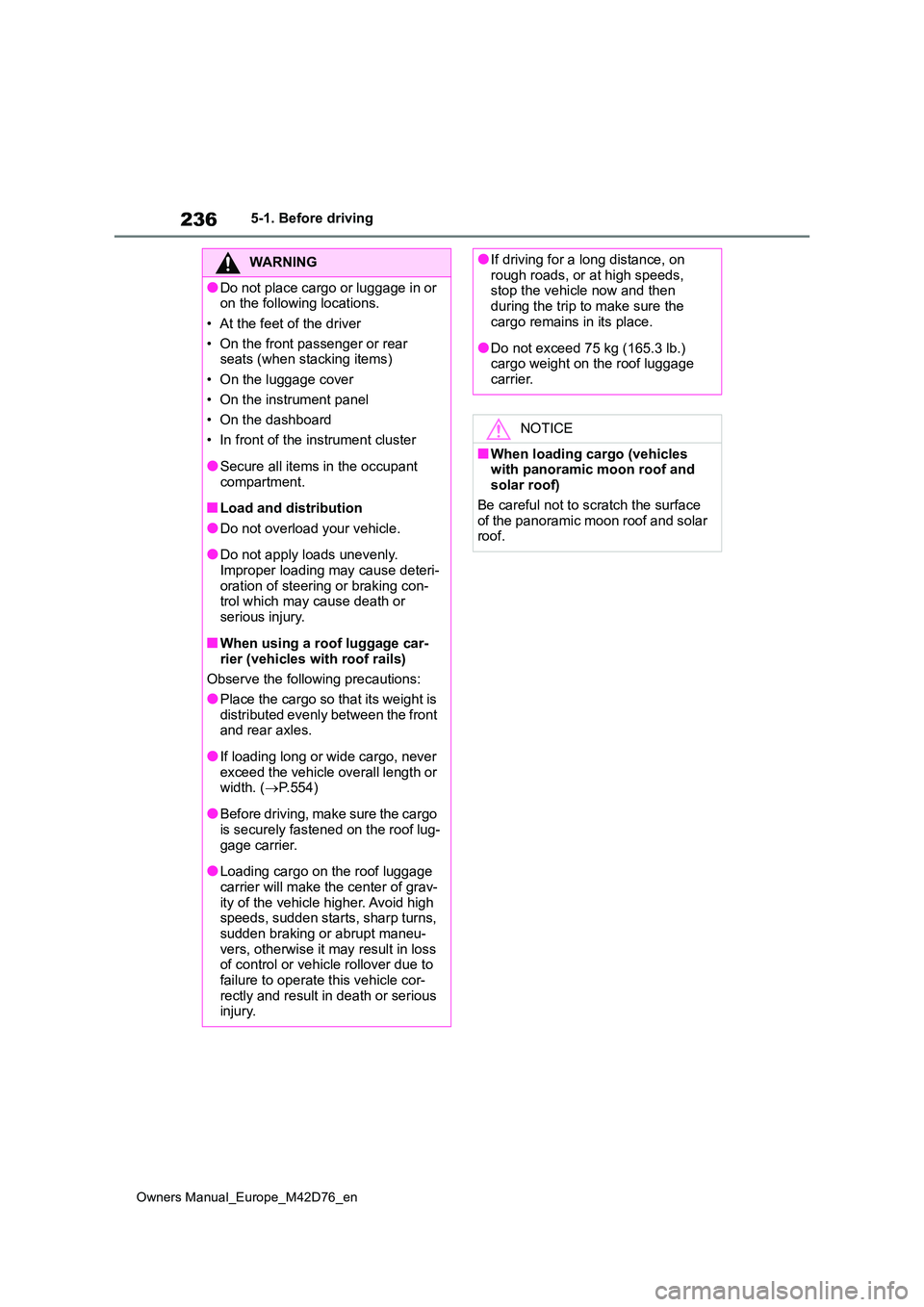
236
Owners Manual_Europe_M42D76_en
5-1. Before driving
WARNING
●Do not place cargo or luggage in or on the following locations.
• At the feet of the driver
• On the front passenger or rear seats (when stacking items)
• On the luggage cover
• On the instrument panel
• On the dashboard
• In front of the instrument cluster
●Secure all items in the occupant
compartment.
■Load and distribution
●Do not overload your vehicle.
●Do not apply loads unevenly.
Improper loading may cause deteri- oration of steering or braking con-trol which may cause death or
serious injury.
■When using a roof luggage car-
rier (vehicles with roof rails)
Observe the following precautions:
●Place the cargo so that its weight is
distributed evenly between the front and rear axles.
●If loading long or wide cargo, never exceed the vehicle overall length or width. ( P.554)
●Before driving, make sure the cargo is securely fastened on the roof lug-
gage carrier.
●Loading cargo on the roof luggage
carrier will make the center of grav- ity of the vehicle higher. Avoid high speeds, sudden starts, sharp turns,
sudden braking or abrupt maneu- vers, otherwise it may result in loss of control or vehicle rollover due to
failure to operate this vehicle cor- rectly and result in death or serious injury.
●If driving for a long distance, on rough roads, or at high speeds, stop the vehicle now and then
during the trip to make sure the cargo remains in its place.
●Do not exceed 75 kg (165.3 lb.) cargo weight on the roof luggage carrier.
NOTICE
■When loading cargo (vehicles with panoramic moon roof and solar roof)
Be careful not to scratch the surface of the panoramic moon roof and solar roof.
Page 297 of 674
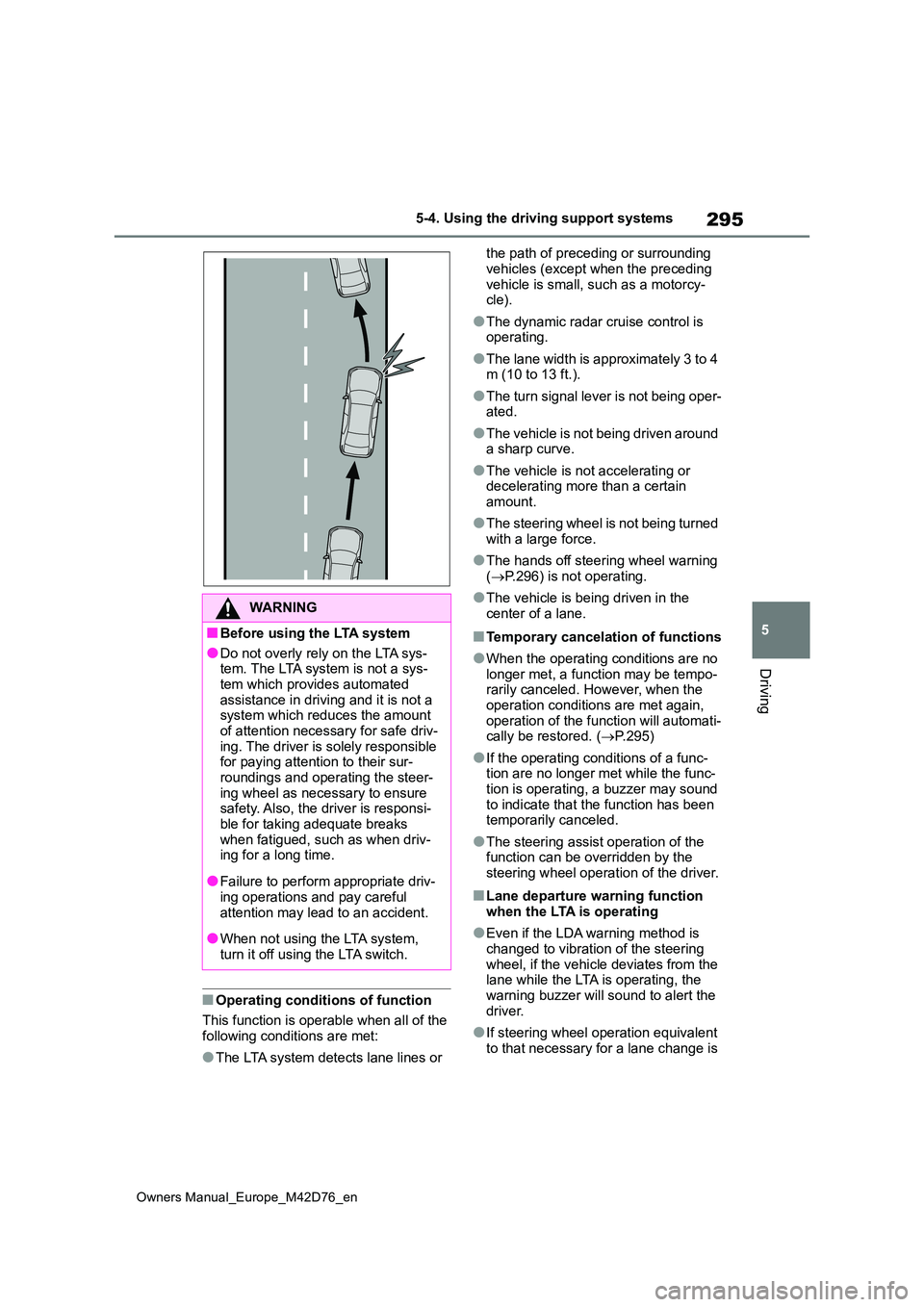
295
5
Owners Manual_Europe_M42D76_en
5-4. Using the driving support systems
Driving
■Operating conditions of function
This function is operable when all of the following conditions are met:
●The LTA system detects lane lines or
the path of preceding or surrounding
vehicles (except when the preceding vehicle is small, such as a motorcy-cle).
●The dynamic radar cruise control is operating.
●The lane width is approximately 3 to 4 m (10 to 13 ft.).
●The turn signal lever is not being oper-ated.
●The vehicle is not being driven around a sharp curve.
●The vehicle is not accelerating or decelerating more than a certain
amount.
●The steering wheel is not being turned
with a large force.
●The hands off steering wheel warning
( P.296) is not operating.
●The vehicle is being driven in the
center of a lane.
■Temporary cancelation of functions
●When the operating conditions are no
longer met, a function may be tempo- rarily canceled. However, when the operation conditions are met again,
operation of the function will automati- cally be restored. ( P.295)
●If the operating conditions of a func- tion are no longer met while the func-tion is operating, a buzzer may sound
to indicate that the function has been temporarily canceled.
●The steering assist operation of the function can be overridden by the steering wheel operation of the driver.
■Lane departure warning function
when the LTA is operating
●Even if the LDA warning method is
changed to vibration of the steering wheel, if the vehicle deviates from the lane while the LTA is operating, the
warning buzzer will sound to alert the driver.
●If steering wheel operation equivalent to that necessary for a lane change is
WARNING
■Before using the LTA system
●Do not overly rely on the LTA sys-tem. The LTA system is not a sys-
tem which provides automated assistance in driving and it is not a system which reduces the amount
of attention necessary for safe driv- ing. The driver is solely responsible for paying attention to their sur-
roundings and operating the steer- ing wheel as necessary to ensure safety. Also, the driver is responsi-
ble for taking adequate breaks when fatigued, such as when driv-ing for a long time.
●Failure to perform appropriate driv-ing operations and pay careful
attention may lead to an accident.
●When not using the LTA system,
turn it off using the LTA switch.
Page 302 of 674
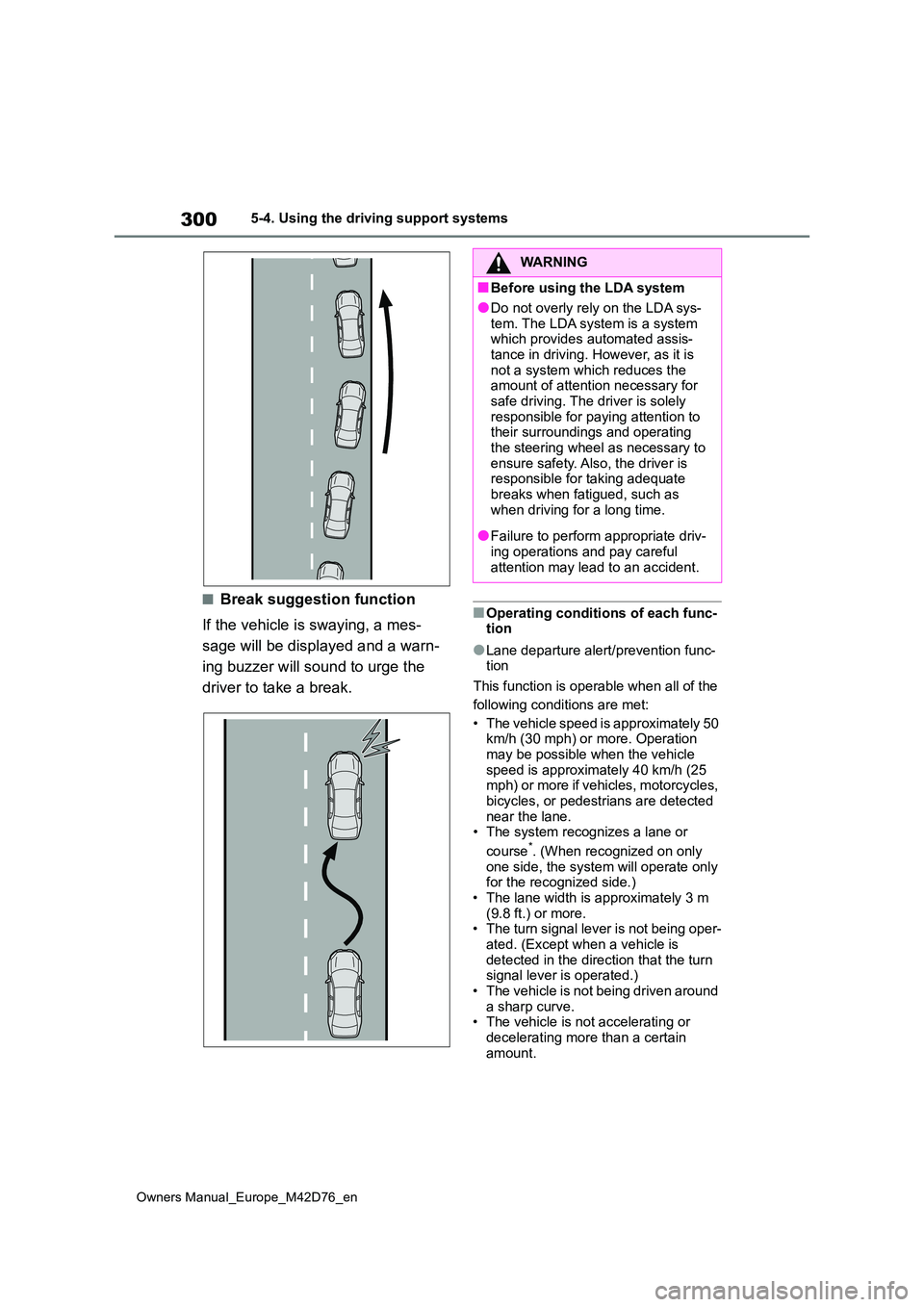
300
Owners Manual_Europe_M42D76_en
5-4. Using the driving support systems
■Break suggestion function
If the vehicle is swaying, a mes-
sage will be displayed and a warn-
ing buzzer will sound to urge the
driver to take a break.
■Operating conditions of each func- tion
●Lane departure alert/prevention func-tion
This function is operable when all of the
following conditions are met:
• The vehicle speed is approximately 50 km/h (30 mph) or more. Operation may be possible when the vehicle
speed is approximately 40 km/h (25 mph) or more if vehicles, motorcycles, bicycles, or pedestrians are detected
near the lane. • The system recognizes a lane or
course*. (When recognized on only
one side, the system will operate only for the recognized side.)• The lane width is approximately 3 m
(9.8 ft.) or more. • The turn signal lever is not being oper-ated. (Except when a vehicle is
detected in the direction that the turn signal lever is operated.)• The vehicle is not being driven around
a sharp curve. • The vehicle is not accelerating or decelerating more than a certain
amount.
WARNING
■Before using the LDA system
●Do not overly rely on the LDA sys-
tem. The LDA system is a system which provides automated assis-tance in driving. However, as it is
not a system which reduces the amount of attention necessary for safe driving. The driver is solely
responsible for paying attention to their surroundings and operating the steering wheel as necessary to
ensure safety. Also, the driver is responsible for taking adequate breaks when fatigued, such as
when driving for a long time.
●Failure to perform appropriate driv-
ing operations and pay careful attention may lead to an accident.
Page 303 of 674
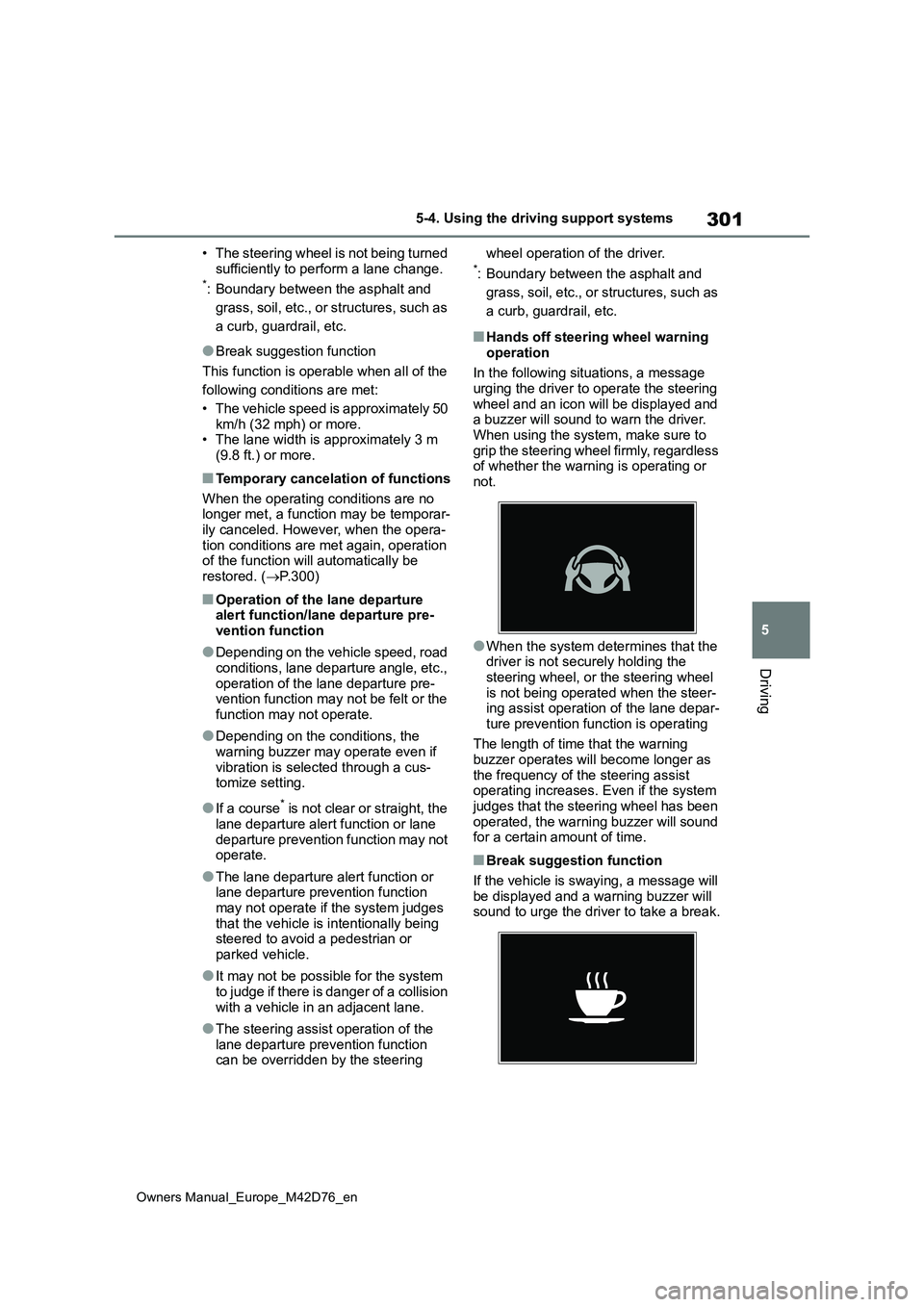
301
5
Owners Manual_Europe_M42D76_en
5-4. Using the driving support systems
Driving
• The steering wheel is not being turned
sufficiently to perform a lane change.*: Boundary between the asphalt and
grass, soil, etc., or structures, such as
a curb, guardrail, etc.
●Break suggestion function
This function is operable when all of the
following conditions are met:
• The vehicle speed is approximately 50 km/h (32 mph) or more.• The lane width is approximately 3 m
(9.8 ft.) or more.
■Temporary cancelation of functions
When the operating conditions are no longer met, a function may be temporar-
ily canceled. However, when the opera- tion conditions are met again, operation of the function will automatically be
restored. ( P.300)
■Operation of the lane departure alert function/lane departure pre-vention function
●Depending on the vehicle speed, road conditions, lane departure angle, etc.,
operation of the lane departure pre- vention function may not be felt or the function may not operate.
●Depending on the conditions, the warning buzzer may operate even if
vibration is selected through a cus- tomize setting.
●If a course* is not clear or straight, the
lane departure alert function or lane
departure prevention function may not operate.
●The lane departure alert function or lane departure prevention function may not operate if the system judges
that the vehicle is intentionally being steered to avoid a pedestrian or parked vehicle.
●It may not be possible for the system to judge if there is danger of a collision
with a vehicle in an adjacent lane.
●The steering assist operation of the
lane departure prevention function can be overridden by the steering
wheel operation of the driver.*: Boundary between the asphalt and
grass, soil, etc., or structures, such as
a curb, guardrail, etc.
■Hands off steering wheel warning
operation
In the following situations, a message urging the driver to operate the steering
wheel and an icon will be displayed and a buzzer will sound to warn the driver. When using the system, make sure to
grip the steering wheel firmly, regardless of whether the warning is operating or not.
●When the system determines that the driver is not securely holding the
steering wheel, or the steering wheel is not being operated when the steer-ing assist operation of the lane depar-
ture prevention function is operating
The length of time that the warning buzzer operates will become longer as
the frequency of the steering assist operating increases. Even if the system judges that the steering wheel has been
operated, the warning buzzer will sound for a certain amount of time.
■Break suggestion function
If the vehicle is swaying, a message will
be displayed and a warning buzzer will sound to urge the driver to take a break.
Page 401 of 674
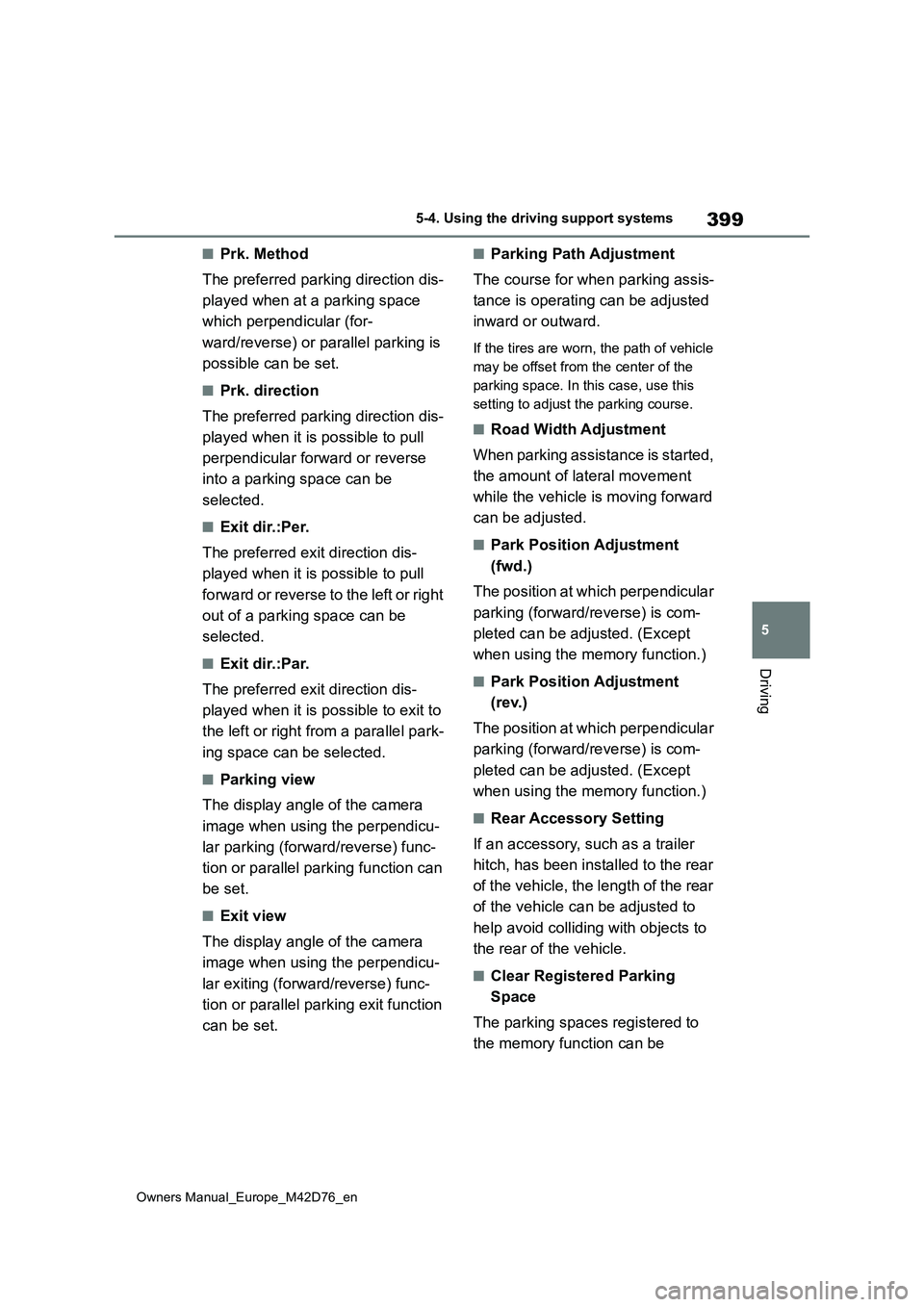
399
5
Owners Manual_Europe_M42D76_en
5-4. Using the driving support systems
Driving
■Prk. Method
The preferred parking direction dis-
played when at a parking space
which perpendicular (for-
ward/reverse) or parallel parking is
possible can be set.
■Prk. direction
The preferred parking direction dis-
played when it is possible to pull
perpendicular forward or reverse
into a parking space can be
selected.
■Exit dir.:Per.
The preferred exit direction dis-
played when it is possible to pull
forward or reverse to the left or right
out of a parking space can be
selected.
■Exit dir.:Par.
The preferred exit direction dis-
played when it is possible to exit to
the left or right from a parallel park-
ing space can be selected.
■Parking view
The display angle of the camera
image when using the perpendicu-
lar parking (forward/reverse) func-
tion or parallel parking function can
be set.
■Exit view
The display angle of the camera
image when using the perpendicu-
lar exiting (forward/reverse) func-
tion or parallel parking exit function
can be set.
■Parking Path Adjustment
The course for when parking assis-
tance is operating can be adjusted
inward or outward.
If the tires are worn, the path of vehicle
may be offset from the center of the
parking space. In this case, use this
setting to adjust the parking course.
■Road Width Adjustment
When parking assistance is started,
the amount of lateral movement
while the vehicle is moving forward
can be adjusted.
■Park Position Adjustment
(fwd.)
The position at which perpendicular
parking (forward/reverse) is com-
pleted can be adjusted. (Except
when using the memory function.)
■Park Position Adjustment
(rev.)
The position at which perpendicular
parking (forward/reverse) is com-
pleted can be adjusted. (Except
when using the memory function.)
■Rear Accessory Setting
If an accessory, such as a trailer
hitch, has been installed to the rear
of the vehicle, the length of the rear
of the vehicle can be adjusted to
help avoid colliding with objects to
the rear of the vehicle.
■Clear Registered Parking
Space
The parking spaces registered to
the memory function can be
Page 415 of 674
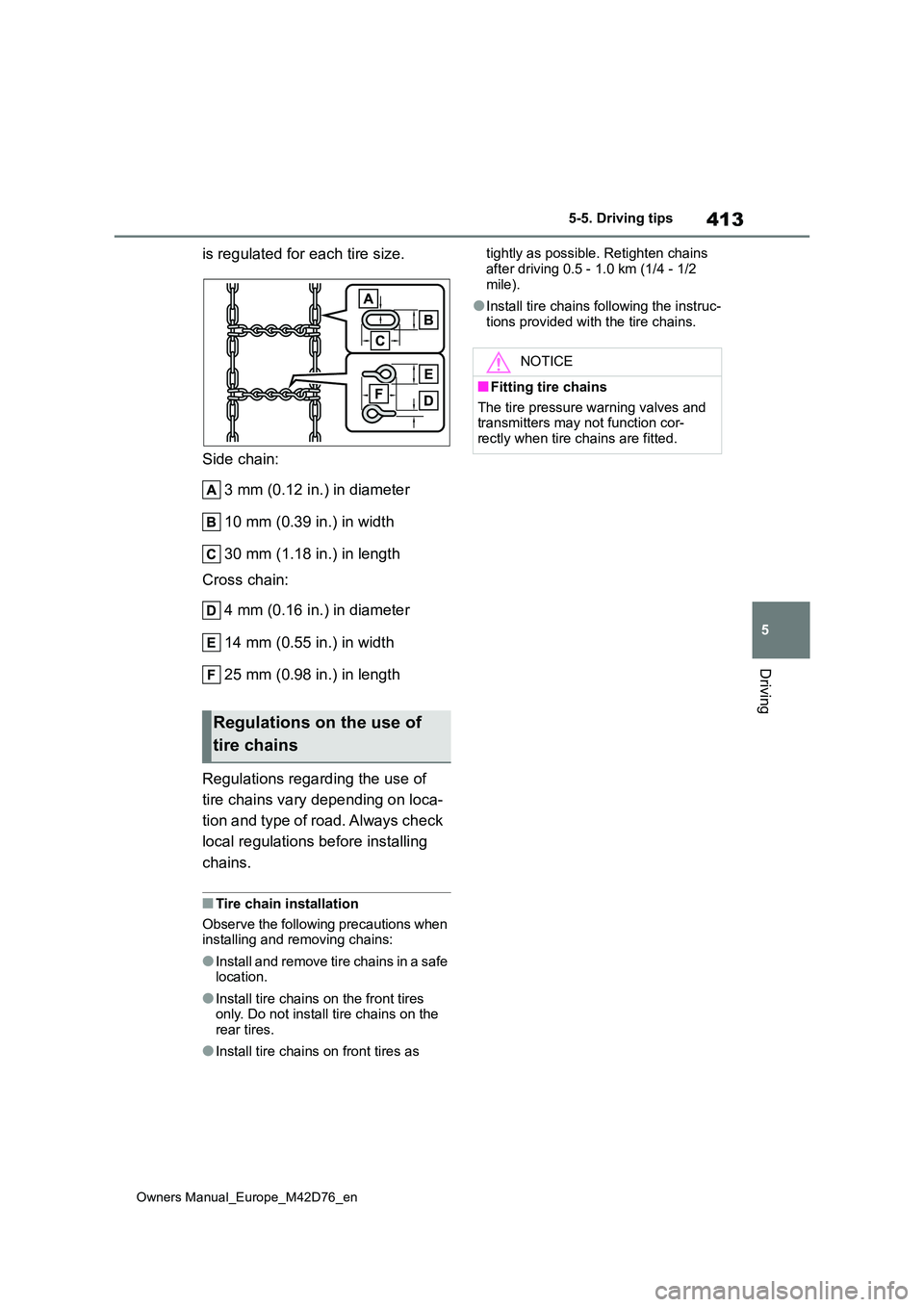
413
5
Owners Manual_Europe_M42D76_en
5-5. Driving tips
Driving
is regulated for each tire size.
Side chain:
3 mm (0.12 in.) in diameter
10 mm (0.39 in.) in width
30 mm (1.18 in.) in length
Cross chain:
4 mm (0.16 in.) in diameter
14 mm (0.55 in.) in width
25 mm (0.98 in.) in length
Regulations regarding the use of
tire chains vary depending on loca-
tion and type of road. Always check
local regulations before installing
chains.
■Tire chain installation
Observe the following precautions when installing and removing chains:
●Install and remove tire chains in a safe location.
●Install tire chains on the front tires only. Do not install tire chains on the rear tires.
●Install tire chains on front tires as
tightly as possible. Retighten chains
after driving 0.5 - 1.0 km (1/4 - 1/2 mile).
●Install tire chains following the instruc-tions provided with the tire chains.
Regulations on the use of
tire chains
NOTICE
■Fitting tire chains
The tire pressure warning valves and transmitters may not function cor-rectly when tire chains are fitted.
Page 497 of 674
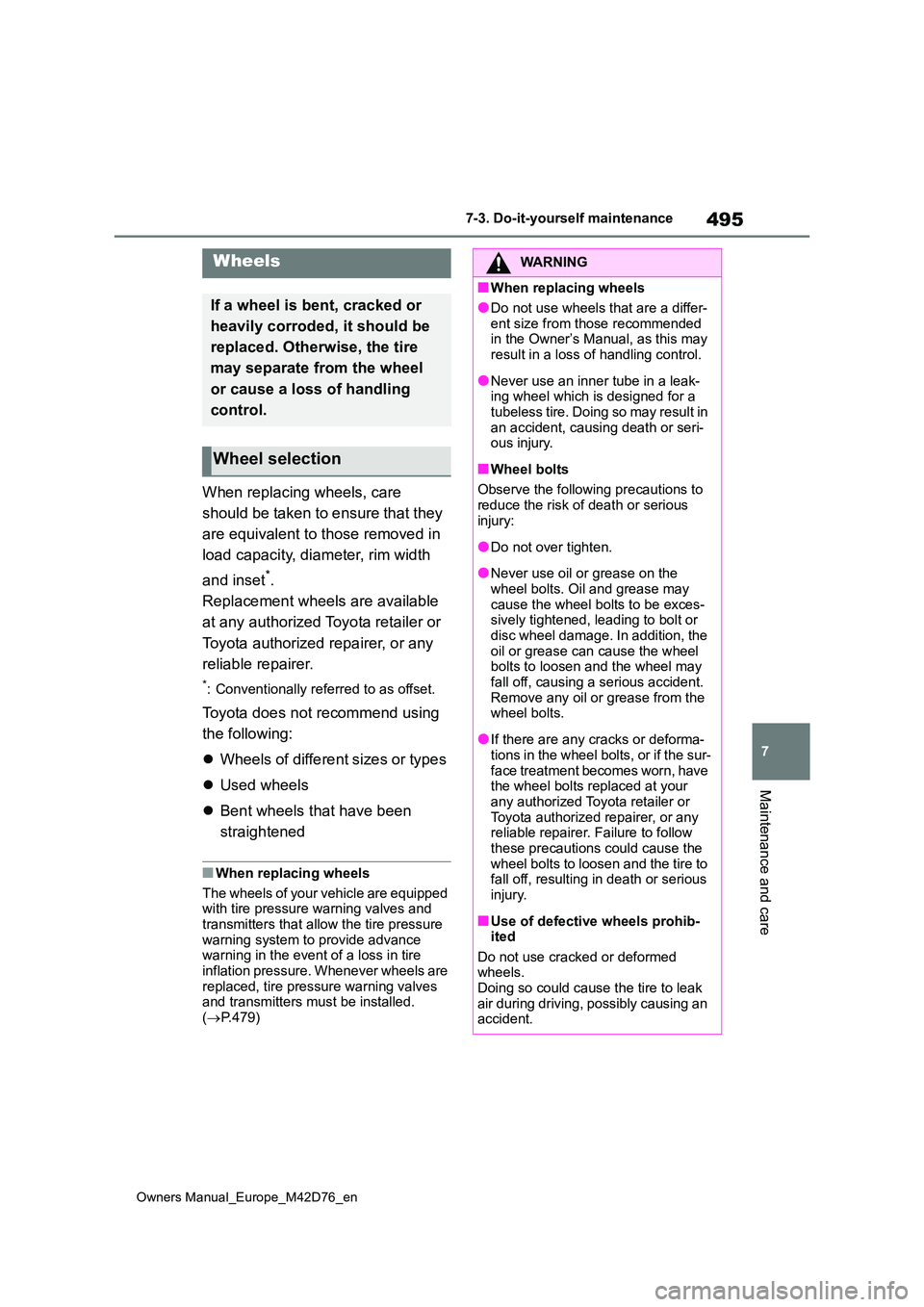
495
7
Owners Manual_Europe_M42D76_en
7-3. Do-it-yourself maintenance
Maintenance and care
When replacing wheels, care
should be taken to ensure that they
are equivalent to those removed in
load capacity, diameter, rim width
and inset*.
Replacement wheels are available
at any authorized Toyota retailer or
Toyota authorized repairer, or any
reliable repairer.
*: Conventionally referred to as offset.
Toyota does not recommend using
the following:
Wheels of different sizes or types
Used wheels
Bent wheels that have been
straightened
■When replacing wheels
The wheels of your vehicle are equipped with tire pressure warning valves and
transmitters that allow the tire pressure warning system to provide advance warning in the event of a loss in tire
inflation pressure. Whenever wheels are replaced, tire pressure warning valves and transmitters must be installed.
( P.479)
Wheels
If a wheel is bent, cracked or
heavily corroded, it should be
replaced. Otherwise, the tire
may separate from the wheel
or cause a loss of handling
control.
Wheel selection
WARNING
■When replacing wheels
●Do not use wheels that are a differ-
ent size from those recommended in the Owner’s Manual, as this may result in a loss of handling control.
●Never use an inner tube in a leak-ing wheel which is designed for a
tubeless tire. Doing so may result in an accident, causing death or seri-ous injury.
■Wheel bolts
Observe the following precautions to
reduce the risk of death or serious injury:
●Do not over tighten.
●Never use oil or grease on the
wheel bolts. Oil and grease may cause the wheel bolts to be exces-sively tightened, leading to bolt or
disc wheel damage. In addition, the oil or grease can cause the wheel bolts to loosen and the wheel may
fall off, causing a serious accident. Remove any oil or grease from the wheel bolts.
●If there are any cracks or deforma-tions in the wheel bolts, or if the sur-
face treatment becomes worn, have the wheel bolts replaced at your any authorized Toyota retailer or
Toyota authorized repairer, or any reliable repairer. Failure to follow these precautions could cause the
wheel bolts to loosen and the tire to fall off, resulting in death or serious injury.
■Use of defective wheels prohib-ited
Do not use cracked or deformed wheels.Doing so could cause the tire to leak
air during driving, possibly causing an accident.
Page 556 of 674
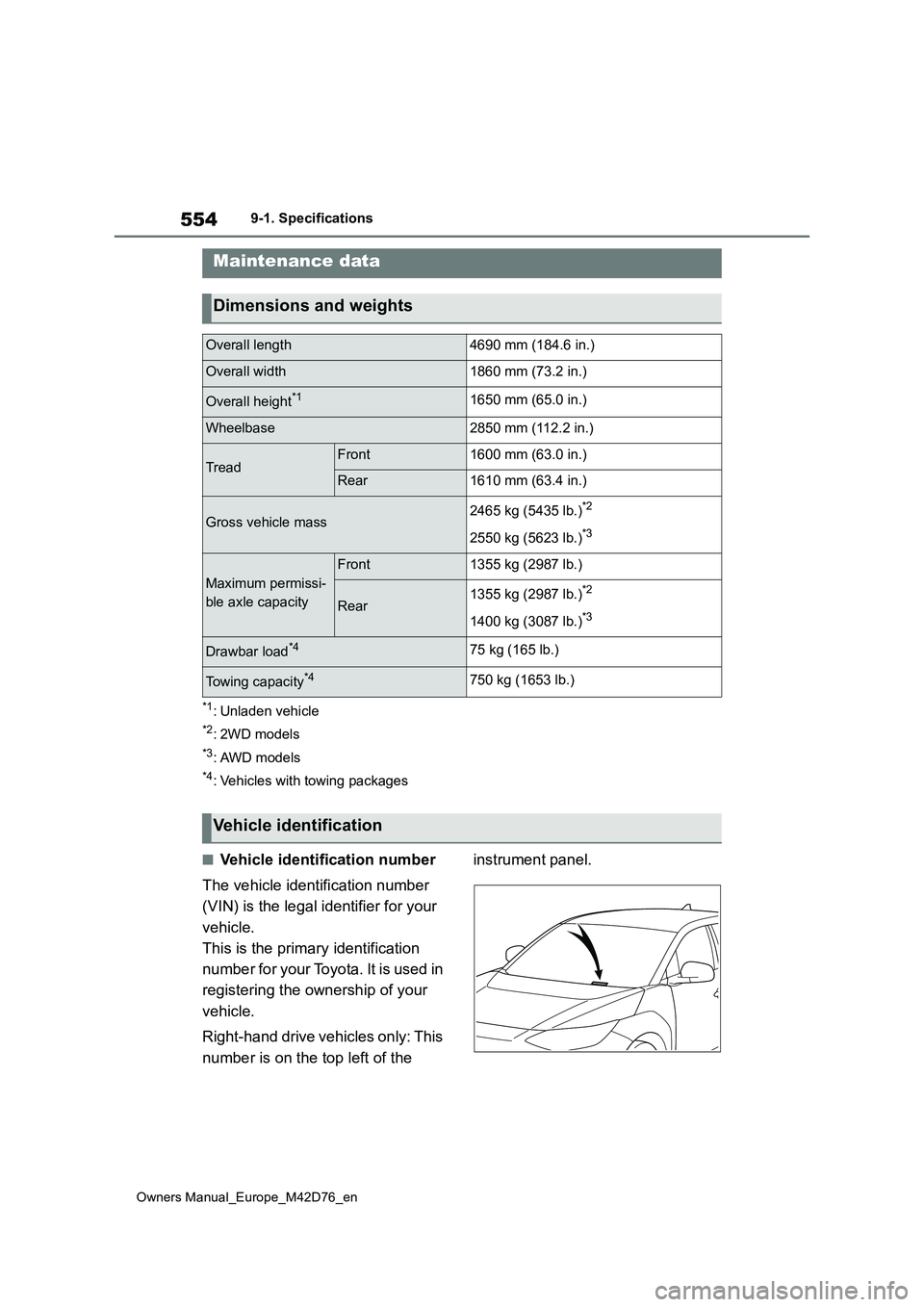
554
Owners Manual_Europe_M42D76_en
9-1. Specifications
9-1.Spec ific ations
*1: Unladen vehicle
*2: 2WD models
*3: AWD models
*4: Vehicles with towing packages
■Vehicle identification number
The vehicle identification number
(VIN) is the legal identifier for your
vehicle.
This is the primary identification
number for your Toyota. It is used in
registering the ownership of your
vehicle.
Right-hand drive vehicles only: This
number is on the top left of the
instrument panel.
Maintenance data
Dimensions and weights
Overall length4690 mm (184.6 in.)
Overall width1860 mm (73.2 in.)
Overall height*11650 mm (65.0 in.)
Wheelbase2850 mm (112.2 in.)
TreadFront1600 mm (63.0 in.)
Rear1610 mm (63.4 in.)
Gross vehicle mass2465 kg (5435 lb.)*2
2550 kg (5623 lb.)*3
Maximum permissi-
ble axle capacity
Front1355 kg (2987 lb.)
Rear1355 kg (2987 lb.)*2
1400 kg (3087 lb.)*3
Drawbar load*475 kg (165 lb.)
Towing capacity*4750 kg (1653 lb.)
Vehicle identification